La Paz Travel Guide
Sitting two and a half miles (4km) above sea level, La Paz is the world's highest capital. Visitors will encounter a city of enthralling contradictions, where efficient airlifts and shimmering hotel facades are as much a part of the experience as diesel engines and ramshackle brickwork.
Fruit sellers, trinket vendors and dapper businessmen, along with alpaca wool-weavers and brightly-dressed Andean women bring a distinct vibrancy to the city, making it a wonderful destination for people-watching. Tourists encounter interesting museums and modern hotels, or marvel at the glorious backdrop of Illimani, the most well-known of Bolivia's lofty peaks. Paintings, handcrafted silver jewellery and beautiful alpaca wool products are among the many items popular on a La Paz shopping spree.
Thrill-seekers may enjoy the Yungas Road (the 'Road of Death') bike tour, which involves a two-hour trip from the city, while others can explore the unique rock formations in the Valley of the Moon. The aerial cable car is a more laid-back experience serving as a perfect way to see the city from above.
Those more interested in the cultural sites will enjoy the National Museum of Ethnography and Folklore, with exhibitions covering pottery, feather art and textiles; while Calle Sagarnaga is an intriguing attraction for the more macabre-inclined, offering witchcraft gifts and trinkets.
Offering a spot to stay close to the great Lake Titicaca, La Paz is a great city to check out for those visiting Bolivia.
Things to do in La Paz
Sightseeing in La Paz can be physically demanding, given its altitude. Visitors should allow themselves time to acclimatise before beginning their adventures. The symptoms of mild altitude sickness should have lessened after a day or two, after which travellers can enjoy the city's signature wonders. People-watching from café windows and sampling local delicacies are popular tourist activities. La Paz's high altitude also means visitors can expect cold conditions, regardless of the season. They should remember to pack warm clothing.
Regarding transport, much of central La Paz is walkable, though hillsides may be challenging. Buses and mini-buses operate along many routes, and plenty of taxis are available. Transport is also extremely cheap. That said, the bus system can seem incredibly chaotic for the uninitiated, making taxis the better bet in most cases.
Travellers should carry small denominations of money, as they'll often find locals who are unwilling or unable to give change for large bills. The advice applies to shopping, sightseeing and taking public transport.
Top tourist attractions include the bizarre and fascinating Witches' Market (Mercado de Brujas), the Mi Teleférico cable car, and the beautiful San Francisco Church (Iglesia de San Francisco). Tourists can choose from a number of walking tours, which take in the main sights and landmarks.
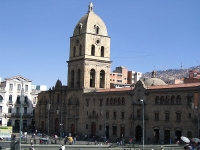
Iglesia de San Francisco
People congregate in this imposing church's plaza, which is a mixture of neo-classical Spanish and mestizo architecture. Construction began in 1549 and only finished in the mid-18th century. Oftentimes, travellers will see colourful Quecha or Aymara wedding processions on Saturday mornings, leading to and from the church. The plaza is a wonderful place to pass the time and watch Bolivian life unfold on any day of the week. Visitors should climb the atmospheric stairway to the fabulous rooftop and enjoy the great views of the city.
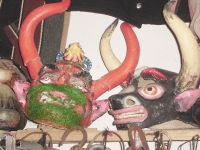
The Witches’ Market (Mercado de Brujas)
Mercado de Brujas (the Witches' Market) offers tourists a truly Bolivian experience. Situated in a maze of narrow alleys in La Paz, it stocks an unusual collection of merchandise, including charms, potions, and herbs used in Aymara traditions. The traditional market scene stretches around it, selling a huge a variety of everyday goods, as well as Andean art and handicrafts. Visitors can expect to see yatiri (witch doctors), who wear dark hats and carry pouches of coca for fortune telling.
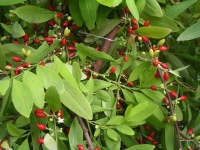
Museo de Coca (Coca Museum)
The museum covers the role of coca in Bolivia's culture and traditions. Visitors will learn about the leaf's healing properties, its use in Andean religious ceremonies, its chemical breakdown and different species. They will also canvas its use by soft-drink and pharmaceutical companies, and how it is turned into cocaine. Actually, one of the institution's missions in to counter the plant's cocaine-related stigma. Among other things, guests will leave knowing how to correctly chew coca leaves, which will allow them to feel its stimulating effects.
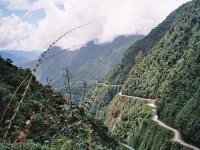
Yungas Road
Yungas Road is not an attraction for the faint of heart. Dubbed the 'El Camino de la Muerte' (Road of Death), it stretches between La Paz and Coroica and claimed 200 to 300 lives every year until 1994. Paraguayan prisoners built the road during the 1930s Chaco War, and it has extreme drops of up to 2,000 feet (609m). The Yungas Road has since become a popular tourist destination among thrill seekers, particularly mountain bikers. It remains dangerous, though, and trucks have serious problems passing each other. Crosses dot the road and mark where cars have plunged off the steep cliff. Drivers on Yungas Road must obey a strict set of rules, as rain and fog often reduce visibility and there are no guard rails. Contrary to normal Bolivian driving rules, drivers keep to the left, and uphill vehicles always have the right of way. Yungas Road has been upgraded with many new safety measures in the last decade, but the original route, now called North Yungas Road, is still in use by tourists.
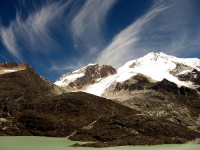
Huayna Potosi
Located in the Cordellera Real range, Huayna Potosi is a tremendous stop for adventurous travellers. The mountain is a mere 15 miles (24km) north of La Paz and only around 1,000 people a year make it to the summit. Many of those who attempt the climb turn back due to cold temperatures and the high altitude. The climb can be done in two daily stages and several difficult snow and ice routes go up the face. Those who make it to the summit will be rewarded with breath-taking views over the Cordillera Real range, Lake Titicaca and La Paz.
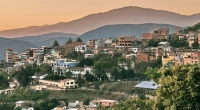
Coroico
Coroico is a relaxing, low-altitude spot where visitors can escape frigid highland nights. The trip from La Paz traverses the Yungas Road, which makes for a photogenic and adrenalin-charged entrance into this laid-back resort town. Perched atop the peak of Cerro Uchumachi, Coroico offers gorgeous views of orchards, forested canyons, cloud-covered mountain tops, and the snow-capped peaks of the Cordillera Real. Coroico is a good base for some interesting hikes into the jungle and for mountain-biking trips into the local area, including guided descents of the precipitous highway.
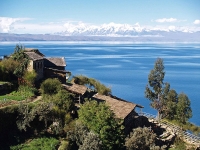
Lake Titicaca
Lake Titicaca is the biggest in South America, and is one of the highest on the planet. Deep and enormous, it borders Bolivia and Peru and sits between Andean mountain ranges. More than 25 rivers flow into the lake, with some 41 islands breaking through the surface of this majestic freshwater giant. Interestingly, the Uros people live on around 62 floating islands made entirely from reeds, and are a must on any trip to Titicaca. Near the southern shore lies the ruins of Tiahuanaco, seen as a remnant of a major pre-Incan civilisation with enigmatic temples and intriguing monoliths.
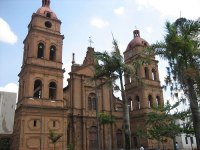
Santa Cruz
In contrast with Bolivia's other cities, Santa Cruz enjoys a tropical feel which can be a welcome break from the harshness of the Andes. Strolling through town is a great way to take in the beautiful colonial architecture before mingling with locals in the Plaza 24 de Septiembre, where they play chess, feed pigeons or sip wine at outdoor cafes. Santa Cruz is also known as the fashion capital of Bolivia, its cosmopolitan atmosphere extending to discos, museums and art galleries. Santa Cruz's comfort and convenience make it an ideal base from which to explore some of Bolivia's most popular attractions, such as Park Amboro, the historical Jesuit missions and La Paz.
La Paz Climate and Weather
La Paz's climate can vary greatly from area to area, owing largely to the differing altitudes across the city. Visitors can expect year-round bright and sunny conditions, though rain can shower down during summer afternoons.
The city's close proximity to mountains means the sun sets relatively early, and temperatures can plummet at night. After-dark temperatures can dip to below freezing in winter. One the plus side, year-round temperatures are cool to mild, with the average being 72°F (22°C) in summer, and 59°F (15°C) in winter.
Winter (May to October) is peak travel season, on account of the drier conditions.
Bolivia travel info
Electricity
220-230 volts, and 50-60Hz. US flat-bladed, two-pin plugs and two-pin plugs with round grounding are used.
Language
Though Spanish is an official language, only 60 to 70 percent of the people actually speak it, often as a second language. Many indigenous languages, such as Quechua and Aymara, are also official.
Money
The official currency is the Bolivian Boliviano (BOB), which is divided into 100 cents (centavos). Money can be exchanged at bureaux de change in the main centres, at banks and hotels - banks are generally considered the best places to exchange currency. Main centres accept USD, but travellers will need cash when they journey to more remote areas.
Banking facilities are good in the main cities and ATMs cater for Visa and MasterCard. Major credit cards such as MasterCard, Dinersclub, Visa, and American Express are accepted in shops, restaurants and the bigger hotels.
Tipping
A service charge is typically added to restaurant and hotel bills in Bolivia, but it is customary to add a five to 10 percent tip for good service over and above this charge. Porters at hotels expect small tips and drivers are only tipped if hired for a full day.
Health
Altitude sickness is the most common complaint in Bolivia, with much of the country lying above 10,000 feet (3,050m). Yellow fever vaccinations are advised as outbreaks do occur, particularly after flooding, and it's a requirement for those entering from infected areas. Malaria is prevalent in some parts of the country, as is dengue fever. It's best to only drink bottled water, and avoid undercooked meat and unpeeled fruit and vegetables. Comprehensive travel insurance is strongly recommended as medical facilities are generally not of a high standard.
Safety
Bolivia is generally a safe destination, though visitors should be vigilant at all times. Pick-pocketing takes place on buses and in crowded areas. Travellers should avoid unlicensed guides and stay away from political demonstrations. Floods and mudslides from heavy rainfall may also strongly affect transport.
Local customs
In conversation, rural Bolivians should be referred to as campesinos rather than Indians, as the later is seen as offensive. 'Machismo' is very much alive and husband and wife roles within the family are very traditional. Homosexuality is frowned upon, particularly in the Altiplano. Formal occasions call for a suit and tie for men, while women should wear dresses. It's also expected to call those older than you 'Señor' and 'Señora' as a polite sign of respect.
Doing business
Relationship building is important is Bolivia, so getting down to business might take some time. Foreigners should remember not to rush things. Negotiations are generally quite slow, and face-to-face communication is preferred over phone calls or written communications. For these reasons, foreigners should be prepared to make many trips before reaching an agreement. Punctuality is expected, even if the meeting doesn't start on time, and schedules are often just a guideline. Consequently, meetings are fairly unstructured and deadlines are often unimportant.
Business people are expected to wear suits. Meetings begin and end with handshakes, with custom demanding that men wait for women to extend a hand first. It's important to include a person's professional title in the greeting if applicable. Otherwise, it's polite to use Señor (Mr) or Señora (Mrs) with a surname. Business cards should also include any academic qualifications, and should have one side translated into Spanish.
Unfortunately, women are generally considered subordinate in the workplace and visiting businesswomen should emphasise their qualifications and work experience. Office hours are generally 8:30am to 6:30pm, Monday to Friday, with a long break over lunch.
Duty free
Travellers to Bolivia over the age of 18 years can bring the following items into the country without incurring customs duty: 400 cigarettes, 50 cigars, and 500 grams of tobacco, 3 litres of alcohol and a reasonable amount of perfume for personal use.
Newly purchased goods to the value of $1,000 per person are also duty free. Travellers departing from the country should note that it is illegal to leave with the following items without prior written permission from the appropriate local authority: pre-Colombian artefacts, historical paintings, items of Spanish colonial architecture and history, and native textiles.
Communications
The international access code for Bolivia is +591. Mobile phones operate on a GSM network, with providers including Entel Movil, Tigo and Viva, while internet usage by the general population is on rise.
Passport & Visa
All visitors travelling by air should have return tickets and all required documents for their next destination, as well as sufficient funds to see them through their stay. All travellers arriving from yellow fever risk areas must show valid yellow fever vaccination certificates on entry to Bolivia. Those who qualify for visas on arrival need to carry all the required documentation translated into Spanish and should confirm these requirements in advance. Travellers who do not have the required fee, documents and photographs for a visa to be issued will be denied entry.
Entry requirements
US nationals must have a valid passport and a visa to enter Bolivia. A visa is obtainable on arrival for a fee payable in cash only, with an invitation letter Bolivian Immigration Authorities (DIGEMIG), a printed hotel reservation, a printed return/onward ticket, and a printed itinerary. The visa is valid for a stay of no more than 30 days.
UK nationals holding valid passports do not need a visa for stays of up to 90 days.
Canadians require a valid passport, but a visa is not necessary for touristic stays of up to 90 days.
Australians need a valid passport, but do not require a visa for touristic stays of up to 90 days.
South Africans require a valid passport on arrival and a visa to enter Bolivia. Visas can be issued on arrival for a fee in cash only, with an invitation letter Bolivian Immigration Authorities (DIGEMIG), a printed hotel reservation, a printed return/onward ticket, and a printed itinerary. Visas can also be obtained at http://www.rree.gob.bo/formvisas/. The visa is valid for a stay of no more than 90 days.
Irish nationals need a valid passport, but do not require a visa for touristic stays of up to 90 days.
New Zealanders need a valid passport, but do not require a visa for a touristic stay of up to 90 days.
Useful contacts
Ministry of Culture and Tourism, La Paz: +591 2 2200910 or http://www.minculturas.gob.bo/
Bolivian emergency numbers are 120 (police), 165 (ambulance) and 119 (fire department).Embassies / consulates in other countries
Bolivian Embassy, Washington DC, United States: +1 202 483 4410.
Bolivian Embassy, London, United Kingdom (also responsible for Ireland): +44 20 7235 4255.
Bolivian Embassy, Ottawa, Canada: +1 613 236 5730.
Bolivian Consulate, Sydney, Australia: +61 2 9247 4235.
Honorary Consulate of Bolivia, Johannesburg, South Africa: +27 11 646 1408.
Embassies / consulates in Bolivia
United States Embassy, La Paz: +591 2 216 8000.
British Embassy, La Paz: +591 2 243 3424.
Canadian Embassy, La Paz: +591 2 241 5141.
Australian Consulate, La Paz: +591 2 2115655
South African Embassy, Lima, Peru (responsible for Bolivia): +511 612 4848.
Consulate of Ireland, La Paz: +591 2 242 1408.



